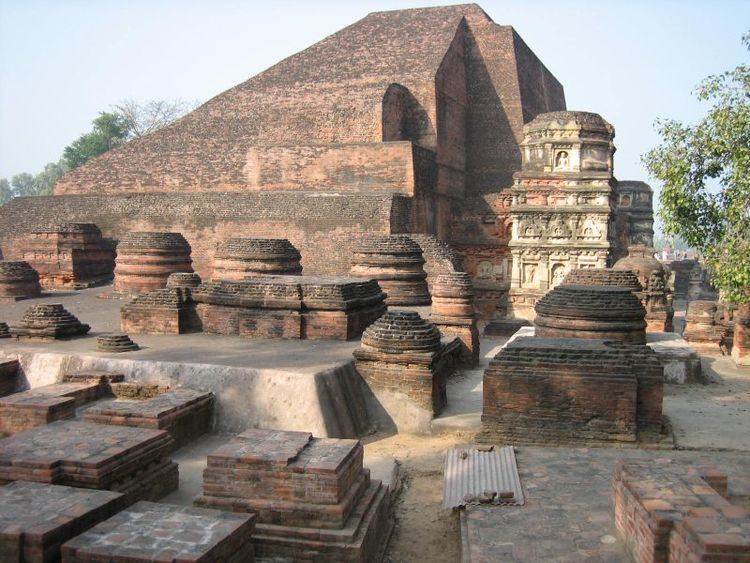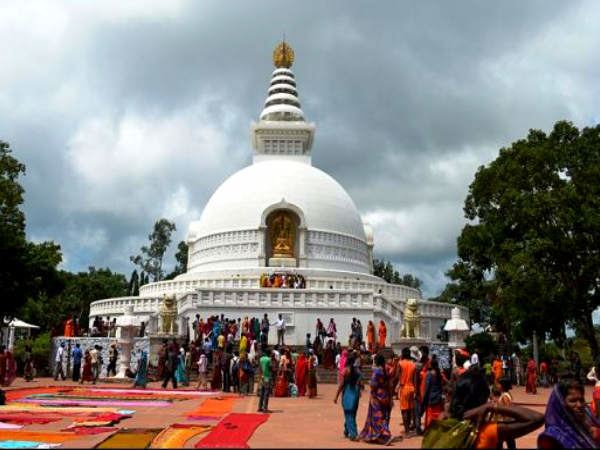Country District | ||
 | ||
Languages spoken Magahi, Hindi, Urdu | ||
Map of Bihar Sharif
Bihar Sharif is the fifth largest city in the eastern Indian state of Bihar and the district headquarters of Nalanda district. The city is a hub of education and trade in south Bihar and the economy centers around agriculture, while also including tourism and household manufacturing. The city is one of the hundred Indian cities competing in a national level competition to get the funds under Narendra Modi's flagship Smart Cities Mission. Bihar Sharif will be competing for the one of last 10 spots against 20 cities from across India.
Contents
- Map of Bihar Sharif
- Bihar sharif city in nalanda bihar
- Bihar sharif smart city nalanda india 2
- Pre Islamic period
- Delhi Sultanate era
- Later history
- Heritage and important sites
- Geography
- Economy
- Demographics
- Religion
- Transport
- References

Bihar Sharif has over two millennia of history. Under the Pala Empire, a major Buddhist (Hindu) monastic university was built at the site and it became the capital of Magadha. It became part of the Muslim Delhi Sultanate in the late 12th century, though local Rajputs soon re-established effective control. In the early 14th century it was permanently captured by the Delhi Sultanate. It was later ruled by other Muslim dynasties and then the British until Indian independence in 1947. The city has important Jain, Buddhist, Hindu, and Muslim heritage and landmarks.

Bihar sharif city in nalanda bihar
Bihar sharif smart city nalanda india 2
Pre-Islamic period

The name Bihar is derived from "Vihar" or "Vihara," meaning Buddhist monastery, a reference to the ancient Odantapuri University established near the city in the 7th century CE by Pala king Gopala I. Bihar Sharif does, however, predate the Buddha. It became the capital of the Magadha kingdom during the rule of the Pala Empire and then until the 14th-century CE. Odantapuri is considered to have been the second oldest of India's Mahaviharas, and it was located at the foot of Bari Pahari (Big Hill). According to Tibetan records, there were about 12,000 students there, and it was an important center of Buddhist learning. Acharya Sri Ganga of Vikramashila was a student there.
Delhi Sultanate era
In 1193, during the time of Ikhtiyar ad-Din Muhammad bin Bakhtiyar Khilji's conquest of Bihar, he came to conquer Nalanda castle which was in fact Nalanda University. En route to Nalanda, he allegedely damaged the Buddhist monasteries of a place now called Bakhtiyarpur. After Bakhtiarpur he came to Vihar, where he completely destroyed Odantapuri University which his spies thought was a castle and the Buddhist viharas before leaving for Nalanda. A few years after Khilji's departure, local Bundela Rajputs regained control of the city from its Muslim rulers. Bundela Rajputs then ruled the area until the time of their leader Raja Biththal, remaining autonomous for all practical purposes despite nominal control from Delhi.
However, Delhi Sultan Muhammad bin Tughluq (r. 1324-1351 CE) then sent Syed Ibrahim Mallick with an army of Afghans to conquer the Magadha region. After a fierce battle, the outnumbered Raja army was defeated and the Raja was killed. The conquest of Bihar was a major achievement for Delhi, and on this occasion, the Sultan conferred upon Syed Ibrahim Mallick the title of “Madarul Mulk,” which means Mallick. After that time, he was called “Mallick Baya”. He was then appointed as governor of Bihar by the Sultan, and he ruled over the region until his assassination in 1353 CE. Descendants of the Bundela Rajputs are now settled in Tungi village and Garhpar in Bihar Sharif.
Later history
After the Delhi Sultanate, the first Sur emperor Sher Shah Suri (r. 1540-1545 CE) moved the regional capital to Patliputra (modern-day Patna), and the whole Magadha region came to be called Bihar.
In 1867, the city was officially declared a municipality.
Tensions between the city's two main religious communities, Hindus and Muslims, simmered from the time of the independence of India and Pakistan from Britain in 1947. On April 30 and May 1, 1981, these boiled over into major violence in which an estimated 150 to 200 Muslim were killed by mobs drawing mainly by communal Hindu, mainly in the city and few in the surrounding villages. The immediate reason was attempts by the RSS to create communal rather than class identity for political purposes. In the aftermath, 550 people were arrested including five high-ranking RSS members.
Heritage and important sites
The town is rich in artifacts and relics from old Buddhist and Jain heritage. (Mahavira, often regarded as the founder of Jainism, is said to have attained Nirvana at the nearby town of Pawapuri.) Broken idols of Buddha and Mahavira can be found in the Nalanda Museum and in many temples. Nalanda College in Bihar Sharif and the locality of Garhpar are the areas where Buddhist monasteries were located. The ruins at Nalanda are 13 km from Bihar Sharif. There is also a notable pillar in Bihar Sharif dating to the 5th century CE at the time of the Gupta empire.
Another famous site in the city is the Langot Fair at Baba Maniram Akhara; the Akhara of Sant Maniram was founded by Raja Biththal to train youth in fighting, and patronized by him and local Rajputs. The mausoleum of Syed Ibrahim Mallick which was really a Temple which was constructed by Pala King Gopala founder of Odantpuri University where thousands of Brahmins brutally killed by Ibrahim Mallick and then the Temple is reshaped as Mosque which is now located at Bari Pahari and is visible from a distance of up to ten kilometers. Badi Dargah, the shrine of the Sufi saint Sheikh Sharfuddin Yahya Maneri, is located near the ruins of Odantapuri. He is credited with converting many Hindus in the districts of Patna, Bihar Sharif, Gaya, Jehanabad, Arwal, Nawada, Jamui and Sheikhpura, and many Muslims celebrate Urs at the shrine each year.
In 2012, plans were announced for the construction of a local Bahá'í House of Worship in Bihar Sharif. This would be only the second House of Worship for India's nearly two million Bahá'ís (the first being the well-known Lotus Temple in Delhi), and one of the first two local Bahá'í Houses of Worship in Asia (the other being in Battambang, Cambodia).
Geography
Bihar Sharif is located 74 km from Patna, the capital of Bihar state (via NH 30 and NH31). It is situated at foot of Badi Pahari (Hiranya Parbat) and on the bank of the Panchanan River. The land around Bihar Sharif is very fertile, with alluvial soil mostly deposited by several rivers of this area. There are many local rivers, including the Mahane, the Panchanan which divide in several parts west of flowing near Pawapuri as Goithwa, Soyaba and small rivers, the Zerain, and others. To the west is the Paimar River, a tributary to the Ganges.
Economy
Agriculture is the main economic activity of Bihar Sharif, including products such as cauliflower, potato, mustard seed and other vegetables, which are sold to neighbouring states. Tourism to nearby sites like Nalanda, Rajgir and Pawapuri also boosts the city's economy considerably, as do footwear and garments manufactured by household industries.
As of 1981, the city had a major beedi cigarette industry which employed 15,000 people, mainly Muslims and some lower-caste Hindus.
The city has changed from a trade-based economy to an education hub. Various schools and coaching centers are a new symbol of awareness about education among people in the rural areas surrounding Bihar Sharif. Some of the latest car and bike showrooms in the city show the effects of modernization.
Bihar Sharif was one of three cities selected in Bihar state to be among the 100 Indian cities developed as smart cities under Prime Minister Narendra Modi's flagship Smart Cities Mission. It was not included in the first twenty cities to receive funding.
Demographics
As of 2011 India census, Bihar Sharif had a population of 297,268, up from 231,972 in 2001 and around 130,000 in 1981. As of 2011, the sex ratio is 916 females per 1000 males, with a slightly higher ratio of 927 females per 1,000 males among children. The overall literacy rate is 75.30%, with male literacy at 80.80% and female literacy at 69.28%. Caste groups with significant populations include the Kurmi, Koyri, Yadav, and Baniyas. Most Muslims speak Urdu and belong to the Sunni Hanafi denomination. The Koyri and Baniya are old settlers while others have moved from villages around city.
Religion
According to the 2011 census, 65.86% of the city's population identifies as Hindu, 33.59% identifies as Muslim, 0.34% did not answer the census question, 0.17% identifies as Christian, and under fifty adherents identify with each other religious group. A 1981 report lists a higher proportion of Muslims, 48%, and notes this as unusual for the area.
In 2013, the Bahá'í World Centre released an hour-and-a-half-long video in five languages entitled Frontiers of Learning, showing Bahá'í community-building activities for people of all religions taking place in four cities from different continents, the fourth of which was Bihar Sharif.
Transport
The town is well connected by road to major cities like Patna, Rajgir, Nalanda, Harnaut, Jamshedpur, Ranchi, Dhanbad, Koderma, Kolkata, Gaya, Hazaribag, Jahanabad, Bakhtiyarpur, Barh, and Ramgarh. Being the district headquarters, it has a regular bus service to all major hubs in the region.
Bihar sharif junction is located on a broad gauge railway branch line connecting Bakhtiyarpur and Tilaiya via Rajgir. The town is served by the Shramjeevi Express, a direct daily superfast train to New Delhi. There are also numerous passenger and express connections to the state capital Patna and Rajgir, from where the rest of India is well connected. Very recently, the Fatuha-Islampur branch line has been connected to this route. The extension of passenger services to inter-link Bihar Sharif with Hilsa, Sheikhpura and Gaya is partially started as of 2013.
The nearest airport is Patna Airport, from which domestic flights to major Indian cities are available.
